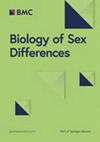雌雄大鼠强迫性酒精自我摄取的机制不同
IF 4.9
2区 医学
Q1 ENDOCRINOLOGY & METABOLISM
引用次数: 0
摘要
在酒精成瘾的发展和治疗过程中,性别是一个重要因素,治疗方法可能必须针对潜在的性别差异进行调整。这凸显了了解行为性别差异的重要性,这些行为反映了临床酒精成瘾的关键因素,如不顾不良后果继续使用("强迫性使用")。对实验动物的研究有助于了解性别对这些行为的影响。我们对大量基因不同的雌雄 Wistar 大鼠进行了强迫性酒精自我给药模型的测试,该模型被定义为在受到脚震惩罚的情况下仍对酒精做出反应。我们还测试了基线(固定比率、未受惩罚)操作性酒精自我管理、自我管理酒精的动机(渐进比率)以及酒精奖励的时间折扣。为了寻找强迫性的预测因素,对动物进行了新奇诱发的场所偏好、焦虑样行为、疼痛敏感性和皮质酮水平的筛查。在整个研究过程中,对动物的发情周期进行了监测。在对酒精摄入量进行体重校正后,雌雄动物在不受惩罚地自我饮酒方面没有差异。总体而言,雌性对酒精的强迫反应水平更高。在使用中间电击强度(0.2 和 0.25 mA)时,雄性大鼠的强迫反应率呈双峰分布,而雌性大鼠则没有;在使用较高电击强度时,雄性和雌性大鼠的反应均受到抑制。我们还发现,当酒精通过延迟交付而贬值时,雌性大鼠的陡峭折扣较少。在不受惩罚的条件下,男性表现出更强的获取酒精的动机,而女性则表现出更高的皮质酮基线水平。因子分析显示,与压力和痛苦相关的潜在维度预测了女性的强迫性,而男性的强迫性则是由奖励因子预测的。在发情周期的不同阶段,我们没有发现酒精相关行为的差异。我们的研究结果表明,酒精成瘾的一个关键特征--强迫性的促进机制可能在男性和女性之间存在差异。这强调了在临床前和临床研究中将性别作为生物变量的重要性,并对酒精成瘾的治疗具有潜在的影响。性别在酒精成瘾的发展和治疗中起着重要作用。男性酒精成瘾的发病率更高,而女性则更容易受到过量饮酒的不良影响。此外,在负面情绪的驱使下,女性往往依赖大量饮酒作为一种不适应的应对机制,以缓解压力和焦虑。另一方面,男性则更有可能在积极情绪和社会影响的作用下大量饮酒并复发。这些性别差异凸显了了解雌雄两性对酒精成瘾的易感性和治疗方法有何不同的重要性。我们利用基因异质性大鼠来探索导致强迫性的行为特征,强迫性是酒精成瘾的一个关键临床特征。我们发现,雄性自我饮酒的动机更高,而雌性则表现出更高的强迫性自我饮酒。在男性中,自我饮酒的动机与强迫性有显著的相关性,而在女性中,基础皮质酮水平较高可预测强迫性。这些发现揭示了性别特异性因素在强迫性酒精自我管理中的重要性,对预防和治疗酒精成瘾具有潜在的意义。本文章由计算机程序翻译,如有差异,请以英文原文为准。
Different mechanisms underlie compulsive alcohol self-administration in male and female rats
Sex is an important factor in the progression and treatment of alcohol addiction, and therapeutic approaches may have to be tailored to potential sex differences. This highlights the importance of understanding sex differences in behaviors that reflect key elements of clinical alcohol addiction, such as continued use despite negative consequences (“compulsive use”). Studies in experimental animals can help provide an understanding of the role sex plays to influence these behaviors. Large populations of genetically heterogeneous male and female Wistar rats were tested in an established model of compulsive alcohol self-administration, operationalized as alcohol responding despite contingent foot shock punishment. We also tested baseline (fixed ratio, unpunished) operant alcohol self-administration, motivation to self-administer alcohol (progressive ratio), and temporal discounting for alcohol reward. In search of predictors of compulsivity, animals were screened for novelty-induced place preference, anxiety-like behavior, pain sensitivity and corticosterone levels. The estrous cycle was monitored throughout the study. Unpunished self-administration of alcohol did not differ between males and females when alcohol intake was corrected for body weight. Overall, females showed higher levels of compulsive responding for alcohol. Compulsive response rates showed bimodal distributions in male but not in female rats when intermediate shock intensities were used (0.2 and 0.25 mA); at higher shock intensities, responding was uniformly suppressed in both males and females. We also found less steep discounting in females when alcohol was devalued by delaying its delivery. Males exhibited a stronger motivation to obtain alcohol under unpunished conditions, while females showed higher corticosterone levels at baseline. Factor analysis showed that an underlying dimension related to stress and pain predicted compulsivity in females, while compulsivity in males was predicted by a reward factor. We did not find differences in alcohol-related behaviors throughout the various stages of the estrous cycle. Our results suggest that mechanisms promoting compulsivity, a key feature of alcohol addiction, likely differ between males and females. This underscores the importance of considering sex as a biological variable in both preclinical and clinical research, and has potential treatment implications in alcohol addiction. Sex plays an important role in the progression and treatment of alcohol addiction. While men show a higher prevalence of alcohol addiction, women are more susceptible to the adverse effects of excessive alcohol consumption. Additionally, women often rely on heavy drinking as a maladaptive coping mechanism to alleviate stress and anxiety, driven by negative affect. On the other hand, men are more likely to report heavy drinking and relapse in response to positive emotions and social influences. These sex-based differences underline the importance of understanding how vulnerability to alcohol addiction and its treatment varies in males and females. We used genetically heterogeneous rats to explore the behavioral traits that contribute to compulsivity, a key clinical feature of alcohol addiction. We found that motivation to self-administer alcohol was higher in males, while females showed higher compulsive alcohol self-administration. In males, motivation to self-administer alcohol showed a significant correlation with compulsivity, while in females compulsivity was predicted by higher basal corticosterone levels. These findings underlie the importance of sex-specific factors in compulsive alcohol self-administration, with potential prevention and treatment implications in alcohol addiction.
求助全文
通过发布文献求助,成功后即可免费获取论文全文。
去求助
来源期刊

Biology of Sex Differences
ENDOCRINOLOGY & METABOLISM-GENETICS & HEREDITY
CiteScore
12.10
自引率
1.30%
发文量
69
审稿时长
14 weeks
期刊介绍:
Biology of Sex Differences is a unique scientific journal focusing on sex differences in physiology, behavior, and disease from molecular to phenotypic levels, incorporating both basic and clinical research. The journal aims to enhance understanding of basic principles and facilitate the development of therapeutic and diagnostic tools specific to sex differences. As an open-access journal, it is the official publication of the Organization for the Study of Sex Differences and co-published by the Society for Women's Health Research.
Topical areas include, but are not limited to sex differences in: genomics; the microbiome; epigenetics; molecular and cell biology; tissue biology; physiology; interaction of tissue systems, in any system including adipose, behavioral, cardiovascular, immune, muscular, neural, renal, and skeletal; clinical studies bearing on sex differences in disease or response to therapy.
 求助内容:
求助内容: 应助结果提醒方式:
应助结果提醒方式:


